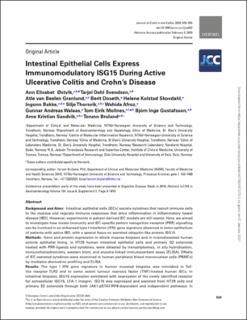| dc.contributor.author | Østvik, Ann Elisabet | |
| dc.contributor.author | Svendsen, Tarjei Dahl | |
| dc.contributor.author | Granlund, Atle van Beelen | |
| dc.contributor.author | Doseth, Berit | |
| dc.contributor.author | Skovdahl, Helene Kolstad | |
| dc.contributor.author | Bakke, Ingunn | |
| dc.contributor.author | Thorsvik, Silje | |
| dc.contributor.author | Afroz, Wahida | |
| dc.contributor.author | Walaas, Gunnar Andreas | |
| dc.contributor.author | Mollnes, Tom Eirik | |
| dc.contributor.author | Gustafsson, Björn | |
| dc.contributor.author | Sandvik, Arne Kristian | |
| dc.contributor.author | Bruland, Torunn | |
| dc.date.accessioned | 2021-02-16T08:56:31Z | |
| dc.date.available | 2021-02-16T08:56:31Z | |
| dc.date.created | 2020-06-09T14:54:22Z | |
| dc.date.issued | 2020 | |
| dc.identifier.citation | Journal of Crohn's and colitis. 2020, 14 (7), 920-934. | en_US |
| dc.identifier.issn | 1873-9946 | |
| dc.identifier.uri | https://hdl.handle.net/11250/2728252 | |
| dc.description.abstract | Background and Aims
Intestinal epithelial cells [IECs] secrete cytokines that recruit immune cells to the mucosa and regulate immune responses that drive inflammation in inflammatory bowel disease [IBD]. However, experiments in patient-derived IEC models are still scarce. Here, we aimed to investigate how innate immunity and IEC-specific pattern recognition receptor [PRR] signalling can be involved in an enhanced type I interferon [IFN] gene signature observed in colon epithelium of patients with active IBD, with a special focus on secreted ubiquitin-like protein ISG15.
Methods
Gene and protein expression in whole mucosa biopsies and in microdissected human colonic epithelial lining, in HT29 human intestinal epithelial cells and primary 3D colonoids treated with PRR-ligands and cytokines, were detected by transcriptomics, in situ hybridisation, immunohistochemistry, western blots, and enzyme-linked immunosorbent assay [ELISA]. Effects of IEC-secreted cytokines were examined in human peripheral blood mononuclear cells [PBMCs] by multiplex chemokine profiling and ELISA.
Results
The type I IFN gene signature in human mucosal biopsies was mimicked in Toll-like receptor TLR3 and to some extent tumour necrosis factor [TNF]-treated human IECs. In intestinal biopsies, ISG15 expression correlated with expression of the newly identified receptor for extracellular ISG15, LFA-1 integrin. ISG15 was expressed and secreted from HT29 cells and primary 3D colonoids through both JAK1-pSTAT-IRF9-dependent and independent pathways. In experiments using PBMCs, we show that ISG15 releases IBD-relevant proinflammatory cytokines such as CXCL1, CXCL5, CXCL8, CCL20, IL1, IL6, TNF, and IFNγ.
Conclusions
ISG15 is secreted from primary IECs upon extracellular stimulation, and mucosal ISG15 emerges as an intriguing candidate for immunotherapy in IBD. | en_US |
| dc.language.iso | eng | en_US |
| dc.publisher | Oxford University Press | en_US |
| dc.rights | Navngivelse-Ikkekommersiell 4.0 Internasjonal | * |
| dc.rights.uri | http://creativecommons.org/licenses/by-nc/4.0/deed.no | * |
| dc.title | Intestinal epithelial cells express immunomodulatory ISG15 during active ulcerative colitis and Crohn's disease | en_US |
| dc.type | Peer reviewed | en_US |
| dc.type | Journal article | en_US |
| dc.description.version | publishedVersion | en_US |
| dc.source.pagenumber | 920-934 | en_US |
| dc.source.volume | 14 | en_US |
| dc.source.journal | Journal of Crohn's and colitis | en_US |
| dc.source.issue | 7 | en_US |
| dc.identifier.doi | 10.1093/ecco-jcc/jjaa022 | |
| dc.identifier.cristin | 1814597 | |
| dc.relation.project | Norges forskningsråd: 223255 | en_US |
| dc.description.localcode | © European Crohn’s and Colitis Organisation (ECCO) 2020. This is an Open Access article distributed under the terms of the Creative Commons Attribution Non-Commercial License (http://creativecommons.org/licenses/by-nc/4.0/), which permits non-commercial re-use, distribution, and reproduction in any medium, provided the original work is properly cited. For commercial re-use, please contact journals.permissions@oup.com | en_US |
| cristin.ispublished | true | |
| cristin.fulltext | original | |
| cristin.qualitycode | 2 | |

